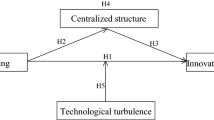Abstract
By applying a network analytical approach, this paper examines the position of technological network in shaping the contribution of a technology in technological development. Between the core and the periphery of the technological network structure, we argue that technologies which occupy a core position of network are in propensity for exploitation in succeeding or derivative technologies. On the contrary, technologies located in periphery position of network are likely to lead to seminal technologies. We empirically test the patent data of insurance business methods and discuss the technological implications of the results.





Similar content being viewed by others
Notes
Borgatti and Everett [2] UCINET 6 for Windows software for social network analysis. Harvard, MA, Analytic Technologies.
References
Baum JAC, Ingram P (2002) Interorganizational learning and network organization: toward a behavioral theory of the interfirm. In: Augier M, March JG (eds) The Economics of Choice, Change and Organization: Essays in Memory of Richard M. Cyert. Edward Elgar, Cheltenham, UK, pp 191–218
Borgatti SP, Everett MG (1999) Models of core/periphery structures. Soc Netw 21:375–395
Breschi, S. Lissoni, F (2005) Knowledge networks from patent data: methodological issues and research targets, in Henk F. Moed, Wolfgang Glänzel and Ulrich Schmoch (Eds.). Handbook of Quantitative Science and Technology Research, the Use of Publication and Patent Statistics in Studies of S&T Systems. Springer, The Netherlands, 613–643
Calero C, van Leeuwen TN, Tijssen RJW (2007) Research cooperation within the bio-pharmaceutical industry: network analyses of copublications within and between firms. Scientometrics 71:87–99
Cantner U, Graf H (2006) The network of innovators in Jena: an application of social network analysis. Res Policy 35:463–480
Castiglionesi, F. Navarro, N (2008) Optimal Fragile Financial Networks. Second Singapore International Conference on Finance 2008. EFA 2008 Athens Meetings Paper
Chen YS, Chang KC (2010) The relationship between a firm's patent quality and its market value—the case of US pharmaceutical industry. Technological Forecasting and Social Change 77(1):20–33
Choi C, Kim S, Park Y (2007) A patent-based cross impact analysis for quantitative estimation of technological impact: the case of information and communication technology. Technological Forecasting and Social Change 74(8):1296–1314
Coleman J (1988) Social capital in the creation of human capital. Am J Sociol 94:95–120
Duysters GM, Hagedoorn J, Lemmens CEAV (2003) The effect of alliance block membership on innovative performance. Revue d’Économie Industrielle 103:59–70, Special Issue on ‘La Morphogénèse des Réseaux’
Freeman LC (1979) Centrality in social networks: I conceptual clarification. Soc Netw 1:215–239
García MAS, Ramos CC (2006) Core/periphery structure models: an alternative methodological proposal. Soc Netw 28:442–448
Griliches Z (1990) Patent statistics as economic indicators: a survey. J Econ Lit 28:1661–1707
Haythornthwaite C (1996) Social network analysis: an approach and technique for the study of information exchange. LISR 18:323–342
Heinze, T (2006) Emergence of Nano S&T in Germany: Network, Formation and Company Performance, Fraunhofer ISI Discussion Papers Innovation System and Policy Analysis, No 7/2006
Joglekar, N (2005) A Behavioral View of Core-Periphery Dynamics in Social Networks. Conference Proceedings, The 23 rd International Conference of the System Dynamics Society, July 17–21, 2005, Boston
Katila R, Ahuja G (2002) Something old, something new: a longitudinal study of search behavior and new product introduction. Acad Manage J 45:1183–1194
Lee S, Yoon B, Lee C, Park J (2009) Business planning based on technological capabilities: patent analysis for technology-driven roadmapping. Technological Forecasting and Social Change 76(6):769–786
Leydesdorff L, Vaughan L (2006) Co-occurrence matrices and their applications in information science: extending ACA to the Web environment. J Am Soc Inf Sci Technol 57(12):1616–1628
Licoppe C, Smoreda Z (2005) Are social networks technologically embedded? How networks are changing today with changes in communication technology. Soc Netw 27(4):317–335
March JG (1991) Exploration and exploitation in organizational learning. Organ Sci 2:71–81
Moody J (2001) Peer influence groups: identifying dense clusters in large networks. Soc Netw 2:261–283
Narin F (1995) Patent as indicators for the evaluation of industrial research output. Scientomertics 34(3):489–496
Podolny JM, Stuart TE, Hanan MT (1996) Networks, knowledge, and niches: competition in the worldwide semiconductor industry, 1984–1991. Am J Sociol 102(3):659–689
Podolny JM, Stuart TE (1995) A role-based ecology of technological change. Am J Sociol 100:1224–1260
Ramlogan R, Mina A, Tampubolon G, Metcalfe J (2007) Networks of knowledge: the distributed nature of medical innovation. Scientometrics 70:459–489
Rank C, Rank O, Wald A (2006) Integrated versus core-periphery structures in regional biotechnology networks. Eur Manag J 24(1):73–85
Scott J (2002) Social Network Analysis: A Handbook, 2nd edn. Sage Publications, London
Sternitzke C, Bartkowski A, Schramm R (2008) Visualizing patent statistics by means of social network analysis tools. World Patent Inf 28(2):115–131
Stuart TE (1998) Network position and propensities to collaborate: an investigation of strategic alliance formation in a high-technology industry. Adm Sci Q 43:668–698
Stuart TE (1999) Interorganizational alliances and the performance of firms. Adm Sci Q 44:315–349
Thompson P (2006) Patent citations and the geography of knowledge spillovers: evidence from inventor- and examiner-added citations. Rev Econ Stat 88(2):383–388
Tsai W (2001) Knowledge transfer in intraorganizational networks: effects of network position and absorptive capacity on business unit innovation and performance. Acad Manage J 44(5):996–1004
Valente TW, Coronges KA, Stevens GD, Cousineau MR (2008) Collaboration and competition in a children's health initiative coalition: a network analysis. Eval Program Plann 31(4):392–402
Vanhaverbeke W, Gilsing V, Beerkens B, Duysters G (2009) The role of alliance network redundancy in the creation of core and non-core technologies. J Manag Stud 46(2):215–244
von Wartburg I, Teichert T, Rost K (2005) Inventive progress measured by multi-stage patent citation analysis. Res Policy 34:1591–1607
Wassermann, S. Faust, K (1994) Social network analysis: methods and applications. Cambridge University Press
Yoon B, Park Y (2004) A text-mining-based patent network: analytical tool for high-technology trend. J High Technol Managem Res 15:37–50
Zaheer A, Bell GG (2005) Benefiting from network position: firm capabilities, structural holes, and performance. Strateg Manage J 26:809–825
Mina A, Ramlogan R, Tampubolon G, Metcalfe J (2007) Mapping evolutionary trajectories: applications to the growth and transformation of medical knowledge. Res Policy 36(5):789–806
Fontana R, Nuvolari A, Verspagen B (2009) Mapping technological trajectories as patent citation networks. An application to data communication standards. Economics of Innovation and New Technology Routledge 18(4):311–336
Verspagen B (2007) Mapping technological trajectories as patent citation networks: a study on the history of fuel cell research. Adv Complex Syst 10(1):93–115
Granovetter M (1985) Economic action and social structure: the problem of embeddedness. Am J Sociol 91:481–510
Burt RS (1992) Structural Holes: The Social Structure of Competition. Harvard University Press, Cambridge, MA
Gulati R, Gargiulo M (1999) Where do interorganizational networks come from? Am J Sociol 104(5):1439–1493
Hall B, Jaffe A, Trajtenberg M (2000) Market Value and Patent Citations: A First Look. NBER Working Paper Series, Cambridge, MA
Baum JAC, Calabrese T, Silverman BS (2000) Don’t go it alone: alliance network composition and startups’ performance in Canadian biotechnology. Strateg Manage J 21:267–294
Boss M, Elsinger H, Summer M, Thurner S (2004) The network topology of the interbank market, Oesterreichische Nationalbank. Quantitative Finance 4:1–8
Duguet E, MacGarvie M (2005) How well do patent citations measure flows of technology? Evidence from French innovation surveys. J Econ Innov New Tech 14(5):375–393
Moody J, McFarland DA, Bender-DeMoll S (2005) Dynamic network visualization: methods for meaning with longitudinal network movies. Am J Sociol 110:1206–1241
Wagner CS (2005) Six case studies of international collaboration in science. Scientometrics 62:3–26
Author information
Authors and Affiliations
Corresponding author
Appendix
Appendix
Rights and permissions
About this article
Cite this article
Weng, C., Daim, T.U. Structural Differentiation and Its Implications—Core/Periphery Structure of the Technological Network. J Knowl Econ 3, 327–342 (2012). https://doi.org/10.1007/s13132-011-0048-5
Received:
Accepted:
Published:
Issue Date:
DOI: https://doi.org/10.1007/s13132-011-0048-5




